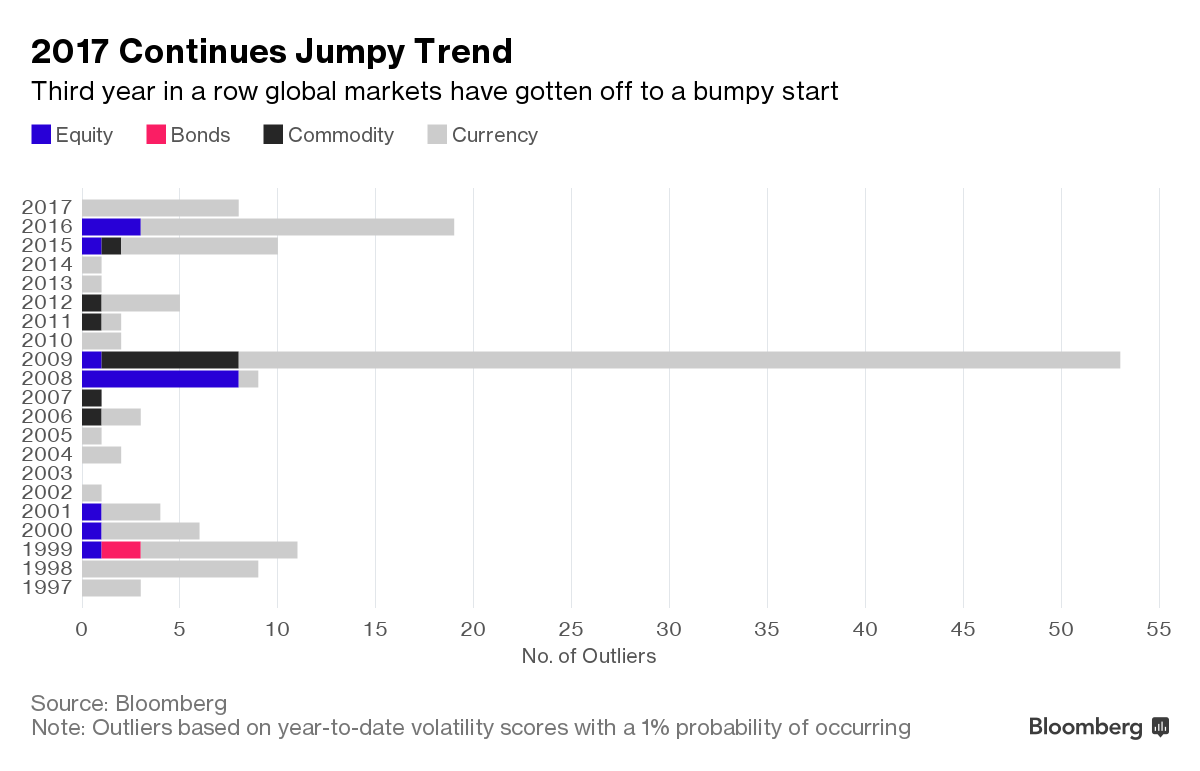The world's most famous measure of volatility in financialmarkets is flashing a sign akin to boredom — languishing aroundlevels that prevailed before the global crisis.
|Problem is, the VIX is tied to the U.S. S&P 500 index. Takea step back to look at the global picture, and the early days of2017 are showing elevated jumpiness similar to that seenduring the past two years.
|Emerging market currencies lead the pack, illustrating both thedangers and potential returns from investing in assets ranging fromEgypt's pound to China's yuan. An investigation into pricefluctuations across financial markets over the past two decades byBloomberg shows how the beginnings of the past two years showed thehighest volatility since 2009, when the world was reeling from theLehman shock and the money market breakdown it unleashed.
|Volatility is likely to trend higher through the course ofthe year as markets react to a range of unknowns, not leastthe impact of U.S. President Donald Trump's agenda, observerssay. Economic policy structures are being reshaped in ways unseenperhaps since before World War II, JPMorgan Chase & Co.strategists said in putting a premium on liquidity in new U.S.stock portfolios.
|“I don't think investors have really felt like volatility isfalling relative to the last couple of years,” Stuart Rumble,investment director with the multi-asset team at FidelityInternational, said in a phone interview from Hong Kong. “We'veseen such a dominant trend over the last couple of months inmarkets, as investors have been positioning for economic growth andhigher inflation following the U.S. election.”
|Looking at 250 assets across market classes that includeequities, sovereign bonds and commodities, eightcurrencies were volatility outliers based on theiryear-to-date price swings, or Z-scores, according to data compiledby Bloomberg as of Jan. 20. A Z-score is a normalized measure basedon price standard deviation, which gauges a security's movescompared with a longer-term average (1997 to 2017).
|
For all the disruptions Trump has brought to longstanding U.S.policies and practices — from trade to regulation — thismonth is still somewhat less volatile than the past twoJanuaries.
|Markets were roiled by confusion over China's currency tacticsand stock slide at the start of 2016 and by Switzerland's surpriseremoval of a cap on the franc in early 2015. Three weeks into2016, there were 19 outliers: 16 currencies and three benchmarkequity indexes.
|At the same stage in 2015, there were 10. That followed afive-year period of relative calm preceded by an eye-popping53 outliers at the start of 2009.
|The Egyptian pound shows up as the most volatile asset in thestudy's universe so far this year. With a Z-score of 4.15, it hasbeen more than twice as volatile as the digital currency bitcoinand six times more jumpy than the Bloomberg Dollar Index. To beclassified as an outlier in this study, an asset needs an absoluteZ-score of 2.575 or more, which means its movements have less thana 1% chance of happening. The greater the score, the greater thevolatility.
|Looking just at the commodity sphere, lean hog futures posted aZ-score of 1.86, making them the most volatile in that group. Hogsalso led the commodity herd in early 2013 and 2015. Argentina'sMerval Index, which hit a record high this week, is the mostvolatile of equity indices for the second year in a row. It had az-score of 1.84 this year and 3.62 in the first three weeksof 2016, shortly after new president Mauricio Macri let the pesofloat freely.
|While a global selloff in bonds since Trump's presidentialelection victory spurred some to call the end of a three-decadebull run in debt, sovereign securities don't stand out asvolatile based on their Z-score calculations.
|On the policy front, one danger for investors to be aware of isthat, unlike in past years, central banks may not be the securityblanket during times of volatility that they havebeen. ”Investors can no longer anticipate that automaticresponse of additional monetary policy when economies or marketstake a downturn,” Rumble said. “That's really what's differentgoing forward over the next several years, and it means when we seethose key risk events, we could see some shock and volatility.”
|Bloomberg News
|Copyright 2018 Bloomberg. All rightsreserved. This material may not be published, broadcast, rewritten,or redistributed.
Complete your profile to continue reading and get FREE access to Treasury & Risk, part of your ALM digital membership.
Your access to unlimited Treasury & Risk content isn’t changing.
Once you are an ALM digital member, you’ll receive:
- Critical Treasury & Risk information including in-depth analysis of treasury and finance best practices, case studies with corporate innovators, informative newsletters, educational webcasts and videos, and resources from industry leaders.
- Exclusive discounts on ALM and Treasury & Risk events.
- Access to other award-winning ALM websites including PropertyCasualty360.com and Law.com.
*May exclude premium content
Already have an account? Sign In
© 2024 ALM Global, LLC, All Rights Reserved. Request academic re-use from www.copyright.com. All other uses, submit a request to [email protected]. For more information visit Asset & Logo Licensing.







